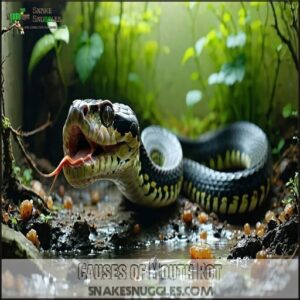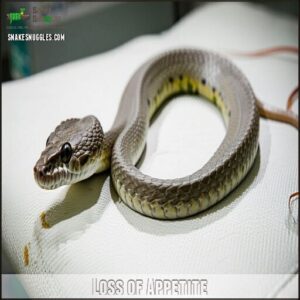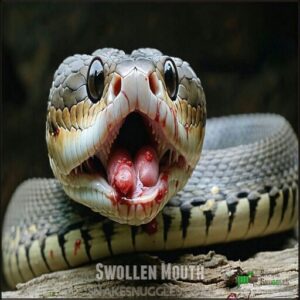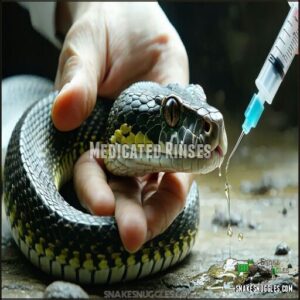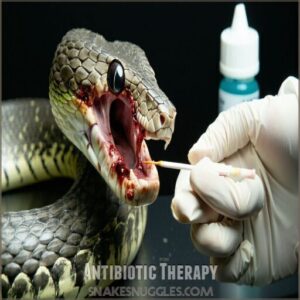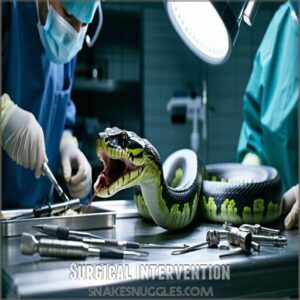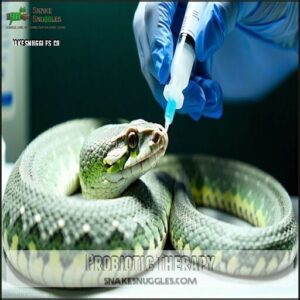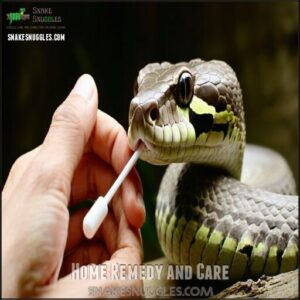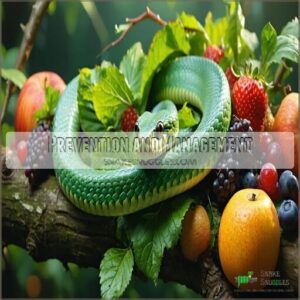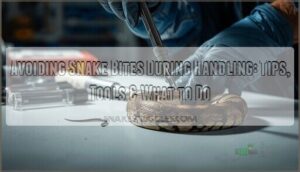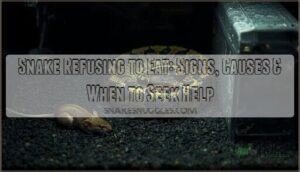This site is supported by our readers. We may earn a commission, at no cost to you, if you purchase through links.

A simple snake mouth rot home remedy involves cleaning their mouth daily with a diluted chlorhexidine solution (1 part solution to 10 parts water).
Use a reptile-safe soft brush or cotton swab for gentle application, and keep their enclosure spotless—think a five-star hotel for reptiles.
Maintain ideal temperatures and humidity to lower stress, as this supports healing, and don’t forget, a balanced diet can help bolster their immune system.
Need more tips? There’s plenty you can do to keep your snake thriving, and remember to act quickly to prevent complications.
Table Of Contents
- Key Takeaways
- Causes of Mouth Rot
- Symptoms and Diagnosis
- Treatment Options Available
- Home Remedy and Care
- Prevention and Management
- Frequently Asked Questions (FAQs)
- How do you treat snake mouth rot?
- Can a snake recover from mouth rot?
- What is snake mouth rot?
- Can snake mouth rot be prevented?
- How do you prevent mouth rot in a snake enclosure?
- Is mouth rot a serious infection in pet snakes?
- Can stress alone cause mouth rot in snakes?
- What types of substrates increase infection risks?
- How does dehydration impact mouth rot recovery?
- Are certain snake species more prone to mouth rot?
- Conclusion
Key Takeaways
- Clean your snake’s mouth daily using a diluted chlorhexidine solution (1 part chlorhexidine to 10 parts water) and a soft reptile-safe brush or cotton swab.
- Keep their enclosure spotless by replacing the substrate weekly, scooping feces daily, and disinfecting surfaces regularly to prevent bacteria buildup.
- Maintain proper temperature and humidity levels specific to your snake’s needs, as these reduce stress and support faster healing.
- Feed a balanced diet with prey variety and ensure proper hydration to strengthen their immune system.
Causes of Mouth Rot
Mouth rot in snakes usually starts with bacteria or fungi taking advantage of a weakened immune system.
Bacteria or fungi often target snakes with weakened immune systems, making good hygiene and stress prevention critical for health.
Poor hygiene, stress, and nutritional deficiencies can create the perfect conditions for these infections to thrive.
Bacterial Infections
Bacterial infections, often caused by Gram-Negative Bacilli like Pseudomonas aeruginosa and Escherichia coli, are common in mouth rot cases.
These thrive in unhygienic conditions or weakened immune systems.
Watch for:
- Klebsiella pneumoniae and Morganella morganii involvement
- Antibiotic resistance complicating treatment
- Cuts allowing bacteria entry
- Overgrowth from poor enclosure hygiene
- MiDOG testing aiding pathogen identification, which can help identify Gram-Negative Bacilli.
Fungal Infections
Fungal infections, like those caused by Aspergillus, can complicate snake mouth rot.
Environmental fungi thrive in humid enclosures, increasing risks of reptile oral infection. Aspergillus impact often leads to stubborn lesions and fungal resistance, making Clotrimazole treatment essential.
Diagnosis challenges arise as symptoms mimic bacterial infections. Lethargy can indicate behavioral changes in snakes.
Prompt care prevents progression, ensuring your snake avoids severe oral infections caused by unchecked fungal growth.
Poor Hygiene
Poor hygiene often stems from water contamination, substrate buildup, and fecal accumulation, creating a breeding ground for bacteria.
Unsanitary housing and improper enclosure design can worsen shedding issues, allowing infections to thrive.
Regular enclosure cleaning is essential for snake hygiene, ensuring a cleaner cage.
By addressing these factors, you can prevent harmful conditions that lead to mouth rot in your snake.
Weakened Immune System
A snake’s immune system weakens due to stress, poor nutrition, coexisting diseases, or unsanitary housing.
Stress reduction and environmental enrichment can strengthen immunity, while probiotics and vitamin supplementation offer immune boosters.
Compromised immune systems make them vulnerable to infections, so maintaining cleanliness and reducing environmental stressors is key.
Address underlying issues to protect against mouth rot effectively.
Nutritional Deficiencies
Nutritional deficiencies often weaken your snake’s immune system, making it prone to mouth rot. A poor diet can lead to vitamin deficiencies, mineral imbalances, and gut health issues.
To prevent this:
- Feed nutrient-rich foods and make certain prey quality matches your snake’s dietary needs.
- Avoid over-supplementation risks by balancing snake vitamins carefully.
- Provide a varied, balanced diet to support overall health.
Symptoms and Diagnosis
Recognizing mouth rot early is vital, as symptoms like loss of appetite, swelling, and discharge can progress quickly.
You’ll need to watch for warning signs such as weight loss, foul odors, or visible sores to facilitate timely diagnosis and care, which can help prevent further complications from foul odors.
Loss of Appetite
Loss of appetite is often the first clue something’s wrong.
Mouth rot pain makes eating difficult, and underlying conditions like infections or poor hydration worsen the issue.
Avoid force-feeding, as it can stress your snake further, and instead, explore dietary adjustments or appetite stimulants.
Natural snake remedies, like ensuring proper humidity, can help, but consult a vet if your snake’s diet remains neglected.
Weight Loss
When a snake stops eating due to mouth rot, weight loss becomes evident over time.
Muscle atrophy may set in, making the spine more pronounced. Dehydration signs, like sunken eyes, often accompany this.
Poor nutritional absorption and a slowed metabolic rate further weaken the snake, potentially leading to organ failure. Recognizing these snake symptoms early can prevent worsening snake mouth rot causes, which may involve mouth rot and lead to significant weight loss.
Discharge or Bleeding
Bleeding or discharge in snake mouth rot often signals infection severity.
Look for:
- Bloody saliva or water bowl contamination.
- Oral lesions with mucus, pus, or cheesy buildup.
- Hemorrhage severity around gums or soft tissue.
Saliva analysis helps identify underlying bleeding causes.
Prompt care, including snake mouth rot remedies like cleaning and medicated rinses, prevents worsening.
Always consult a vet for proper diagnosis.
Foul Smell
A foul smell often signals advanced stages of snake mouth rot, stemming from bacterial sources like Pseudomonas or Escherichia coli.
Odor intensity varies, with strong, sour scents indicating severe infection. Proper hygiene impacts smell differentiation, as neglected enclosures worsen odors.
Identifying snake mouth rot symptoms early aids in snake infection cure. Remedies focus on cleaning and addressing mouth sores promptly.
| Factor | Description |
|---|---|
| Odor Intensity | Strong smell signals severe infection. |
| Bacterial Source | Commonly Pseudomonas or E. coli. |
| Hygiene Impact | Poor hygiene worsens foul odors. |
| Smell Differentiation | Helps assess infection severity. |
| Advanced Stages | Sour odor indicates critical condition. |
Swollen Mouth
A swollen mouth is a common sign of snake mouth rot, often linked to tissue damage and oral discomfort.
You might notice facial asymmetry, eating difficulty, or joint immobility.
Look for these signs:
- Red, inflamed gums or lips.
- Blisters or snake mouth sores.
- Difficulty opening the mouth.
- Swelling affecting one side more than the other.
This can be due to bacterial or fungal infections that require treatment.
Treatment Options Available
To treat snake mouth rot effectively, you’ll need to combine medicated rinses, antibiotics, and proper supportive care.
Combine medicated rinses, antibiotics, and supportive care to effectively treat snake mouth rot and ensure a smooth recovery.
In severe cases, surgical intervention and probiotic therapy may be necessary to restore your snake’s health and prevent complications, which can be a critical aspect of effective treatment.
Medicated Rinses
Keeping the mouth clean is key to managing oral infection in reptiles.
Use rinse solutions like diluted chlorhexidine or povidone-iodine to flush bacteria without harming healthy tissue. Apply with a sterile swab, ensuring thorough coverage.
Avoid swallowing risks by tilting the snake’s head downward. A good option is to find a suitable snake rinse.
Rinse frequency should be daily, followed by post-rinse care to reduce bacterial infection and promote healing. This approach helps in managing oral infection.
Antibiotic Therapy
Antibiotics are key to fighting bacterial infections like mouth rot. They come in various forms—oral, topical, or injectable.
To guarantee success:
- Follow your vet’s dosage calculation precisely.
- Watch for side effects like lethargy or appetite loss.
- Use medicated solutions or topical creams as prescribed.
- Address antibiotic resistance with culture-based treatments.
- Stick to the full treatment duration for effectiveness.
Many owners purchase snake antibiotics online for convenience.
Surgical Intervention
Surgical intervention is vital for advanced snake mouth rot.
Veterinarians use debridement techniques to remove dead tissue, often under careful anesthesia protocols to minimize risks.
Infections reaching bone involvement may require bone debridement or tissue reconstruction.
Post-op care includes thorough monitoring and fluid therapy to guarantee healing.
Surgery is a last resort, but it’s effective when paired with proper follow-up.
Specialized instruments, like snake debridement tools, are essential for these procedures.
| Key Aspect | Description |
|---|---|
| Procedure | Debridement, tissue removal, surgery |
| Risk Management | Anesthesia protocols, infection risks |
| Recovery Measures | Post-op care, monitoring, hydration |
Supportive Care
Supportive care is essential for snake mouth rot relief.
Fluid therapy keeps your snake hydrated, while pain management reduces discomfort, making recovery smoother.
If symptoms worsen, hospitalization needs may arise for intensive care.
Boost healing by maintaining proper heat levels and a stress-free environment.
These steps, paired with other snake remedies, facilitate effective home remedy support for your reptile’s recovery.
Probiotic Therapy
Probiotic therapy helps restore your snake’s gut microbiome, offering immune support and reducing harmful bacteria.
Probiotic strains like Lactobacillus-based supplements improve gut health and encourage healing.
Always consult a vet to confirm species specificity and safe dosing.
Long-term effects, including better gut health, can lower infection risks, and probiotics support recovery, making them a valuable addition to your snake’s care routine, which provides better gut health.
Home Remedy and Care
You can manage mild cases of snake mouth rot at home with simple yet effective care techniques.
By focusing on cleaning, reducing stress, and ensuring proper hygiene, you’ll help your snake heal and avoid complications.
Daily Chlorhexidine Rinses
Daily chlorhexidine rinses are a simple yet effective step in snake mouth rot treatment.
Dilute the solution properly to avoid irritation, using about 1 oz of chlorhexidine per gallon of water. Apply gently using a cotton swab, focusing on inflamed areas.
Reptile-safe disinfectants such as chlorhexidine are often recommended by vets.
Rinse frequency matters—twice daily works well. Watch for potential risks like accidental ingestion for safer, long-term effects, and consider the importance of proper treatment.
Reptile-Specific Soft Brushes
Reptile-specific soft brushes are essential for snake mouth care, offering gentle bristle softness to clean sensitive areas without harm.
Choose a brush size suited for your snake’s mouth; smaller heads work best for precision.
Use proper technique, brushing delicately to remove debris and maintain oral hygiene.
Regular cleaning frequency keeps infections at bay, ensuring ideal snake oral health.
Thorough Cleaning
Gently clean your snake’s mouth using a sanitized Q-tip dipped in diluted antiseptic solutions like 1% povidone-iodine.
Remove debris carefully to avoid injury, then flush the mouth with chlorhexidine solution.
Regular rehydration soaks improve recovery by easing discomfort.
Keep the enclosure clean and maintain cage hygiene to prevent bacterial buildup.
A clean habitat is essential for effective long-term care.
Pain Relief
For snake pain relief, consider analgesic options like meloxicam prescribed by a vet.
Reducing inflammation is essential, so focus on soothing techniques like lukewarm soaks.
A comfortable enclosure helps recovery, while dietary adjustments support healing.
Avoiding stress can enhance natural treatments for snakes, and these steps make home remedies for snakes effective in mouth rot treatment.
Stress-Free Environment
Creating a stress-free environment is key to aiding recovery.
Make certain the snake habitat includes Enclosure Enrichment like Hiding Places to help your pet feel secure.
Reduce noise and minimize interaction to lower snake stress. Gentle Handling Techniques prevent additional discomfort.
A calm, well-maintained snake environment promotes healing, making it easier for your snake to regain its natural balance.
Prevention and Management
You can prevent mouth rot by maintaining proper enclosure conditions, including ideal temperature gradients, controlled humidity, and regular cleaning.
Pairing a balanced diet with routine veterinary check-ups guarantees your snake stays healthy and less prone to infections.
Ideal Temperature Gradients
Maintaining the right temperature gradients is vital for a healthy snake environment.
Adjust to your snake’s species variation by:
- Providing a basking spot at 85-90°F for proper digestion.
- Keeping night temperatures stable, not dropping below 75°F.
- Using reliable heating methods like heat mats or lamps.
- Engaging in consistent temperature monitoring to guarantee ideal environmental conditions.
These steps build a stress-free, supportive space!
Humidity Control
Proper humidity control keeps your snake healthy and prevents shedding problems or respiratory infections.
Use a reliable humidity gauge to monitor levels, ensuring they stay within your pet’s ideal humidity range.
Hydration levels matter too—mist the enclosure or adjust water placement if needed.
A well-designed enclosure helps maintain balanced humidity, providing a stable, comfortable environment that supports overall well-being.
Enclosure Cleanliness
A clean environment is essential for maintaining enclosure cleanliness.
Follow these five steps for a healthier habitat:
- Replace the substrate weekly to avoid bacteria buildup.
- Scoop feces daily for consistent cage maintenance.
- Guarantee water quality by changing bowls regularly.
- Use disinfection protocols monthly for vivarium cleaning.
- Inspect cage furnishings for damage and sanitize them.
A key step is to remove waste promptly and maintain consistent cage maintenance for a healthier habitat with clean environment.
Balanced Diet
A nutrient-rich diet strengthens snake immunity, preventing mouth rot.
Focus on prey variety to meet nutritional needs while avoiding obesity. Always consider supplementation needs for vitamins and minerals.
Proper hydration importance can’t be overstated—offer clean water daily.
Balanced snake nutrition supports healthy digestion and nutrient absorption. Avoid overfeeding; moderation helps maintain health.
Consult experts if unsure about snake diet specifics.
Regular Veterinary Check-Ups
Don’t ignore how vital regular veterinary check-ups are for your snake’s health.
Early detection of mouth rot and other snake health issues can save its life. Snake vet care provides expert advice and treatment planning.
- Schedule annual exams for health monitoring.
- Watch for small signs of illness.
- Discuss reptile health tips with your vet.
- Keep updated on snake mouth rot prevention.
- Prioritize preventative care.
Frequently Asked Questions (FAQs)
How do you treat snake mouth rot?
Treat snake mouth rot by cleaning the mouth with diluted chlorhexidine, removing debris gently, and boosting enclosure hygiene.
Increase temperatures slightly to aid recovery, make certain proper hydration, and consult a vet for antibiotics if symptoms worsen, which can be crucial for preventing further complications.
Can a snake recover from mouth rot?
Yes, your snake can recover from mouth rot with proper treatment.
Prompt veterinary care, a clean environment, and supportive care like prescribed antibiotics or antifungals are key.
Address underlying issues to prevent recurrence.
What is snake mouth rot?
Imagine noticing your snake drooling or avoiding food.
Mouth rot, or infectious stomatitis, is a bacterial or fungal infection causing redness, swelling, and sores in the mouth.
Poor enclosure hygiene often triggers this condition.
Can snake mouth rot be prevented?
You can prevent snake mouth rot by keeping the enclosure clean, maintaining proper temperature and humidity, and providing a balanced diet.
Regularly inspect your snake, make certain stress-free handling, and address health issues promptly.
How do you prevent mouth rot in a snake enclosure?
Keep the enclosure clean, maintain proper humidity and temperature, and avoid overcrowding.
Feed pre-killed prey to prevent injuries.
Regularly check for debris or waste, as these can promote bacteria, stressing your snake’s immune system.
Is mouth rot a serious infection in pet snakes?
Mouth rot is a serious infection in snakes, affecting their ability to eat and breathe.
Left untreated, it can spread to surrounding tissues or bones, causing severe pain and complications.
Prompt care guarantees better outcomes.
Can stress alone cause mouth rot in snakes?
Stress alone won’t directly cause mouth rot, but it weakens your snake’s immune system, giving bacteria or fungi a chance to invade.
Poor care, like improper humidity or dirty enclosures, makes stress a bigger threat.
What types of substrates increase infection risks?
Loose, damp, or soiled substrates like wood chips, soil, or sand can harbor bacteria and fungi, raising infection risks.
Stick with easy-to-clean options like paper towels or reptile carpet for better hygiene and safety.
How does dehydration impact mouth rot recovery?
Dehydration slows mouth rot recovery by weakening the immune system and reducing tissue healing.
Your snake needs proper hydration to fight infection and repair damaged areas, so offer daily soaks in lukewarm water to boost recovery.
Are certain snake species more prone to mouth rot?
Think of certain species, like green tree pythons and ball pythons, as having more fragile immune systems or tighter humidity needs, making them more susceptible.
Improper care or stress often turns their vulnerability into full-blown mouth rot.
Conclusion
Think of snake care like maintaining a well-oiled machine—consistent attention keeps everything running smoothly.
When addressing snake mouth rot, early intervention is key. Use the simple snake mouth rot home remedy of daily chlorhexidine rinses, verify their habitat is spotless, and maintain proper temperature and humidity levels.
Pair this with a balanced diet to help your snake heal faster. By staying proactive, you can ease your snake’s discomfort and prevent severe complications, keeping them thriving and healthy, which is the ultimate goal of proper care.

